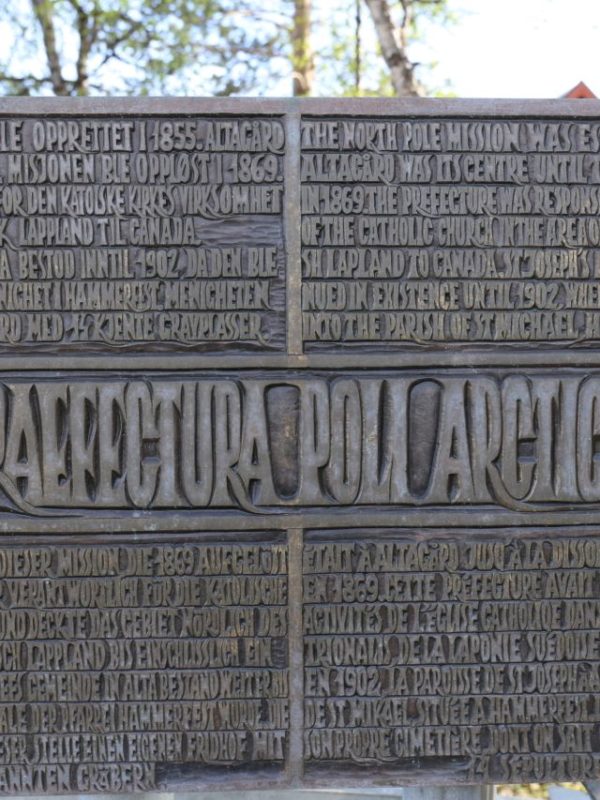![]() Nordpolmisjonen (Praefectura Apostolica Poli Arctici) var et katolsk apostolisk prefektur som ble opprettet i 1855 for å drive misjonsarbeid. Dette skulle foregå først og fremst i områder nord for polarsirkelen, men også noen andre områder ble tatt med. Virkeområdet dekket således:
Nordpolmisjonen (Praefectura Apostolica Poli Arctici) var et katolsk apostolisk prefektur som ble opprettet i 1855 for å drive misjonsarbeid. Dette skulle foregå først og fremst i områder nord for polarsirkelen, men også noen andre områder ble tatt med. Virkeområdet dekket således:
• Norge og Sverige nord for polarsirkelen
• Kolahalvøya
• Island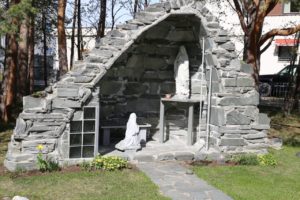
• Grønland
• Færøyene
• Det arktiske Nord-Amerika fra Baffin Bay til Melville
• Shetland
• Orknøyene
• Caithness i Skottland
Opprettelsen ble foretatt 8. desember 1855 av Den hellige kongregasjon for troens utbredelse i et dekret undertegnet av prefekt Giacomo Filippo kard. Fransoni. Nordpolmisjonen hadde 1856-65 sitt hovedkvarter på Altagård i Alta.
Den første lederen for misjonen var Paul Marie Etienne de Djunkovskij
I 1869 ble misjonen oppløst av Pius IX fordi man i Roma innså at Den katolske kirke i Norge måtte organiseres annerledes. Enkelte menigheter som ble opprettet gjennom Nordpolmisjonen eksisterer fortsatt, som St. Mikael i Hammerfest.
Kilde: Wikipedia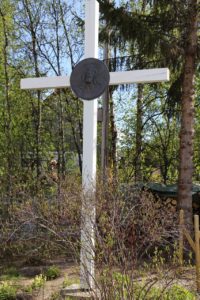
Nordpolmisjonen 150 år
Av Helmut Krane, Tromsø. Se også pavelige dokumenter i forbindelse med opprettelsen av Nordpolmisjonen.
I 2005 er det 150 år siden Roma opprettet «Praefectura Apostolica Poli Arctici» med formålet å drive misjon fortrinnsvis i områder nord for polarsirkelen. «Misjonen i de arktiske områder», vanligvis omtalt som «Nordpolmisjonen», omfattet på det største de arktiske deler av Norge og Sverige, Kolahalvøya, Island, Grønnland, Færøyene, arktisk Amerika fra Baffinbukta til øya Melville, Shetlandsøyene, Orknøyene og grevskapet Caithness i Skottland.
Historisk stoff om misjonen finnes i mange kilder, særlig i «Norvegia Catholica» (Kjelstrup 1942, «Den katolske kirke i Norge» (1943), «Nordpolmisjonen» (p. Alois Brodersen mag.gr.avh.) og Karmelittsøster Nadas hefte fra 1993 («Den katolske kirke i Nord-Norge 1537-1932»). Den siste gir i en kortfattet versjon historien om prefekt Paul Maria Stefan de Djunkowsky i spissen for en gruppe på 6 som kom til Alta i 1856. Alta ble valgt som base for misjonsvirksomheten, og her ble det umiddelbart opprettet kapell, og en gutteskole ble startet 1857. Samme år ble folk sendt ut på misjonsoppdrag til Island, Skottland, Shetlandsøyene og Færøyene og det ble samlet inn penger i på Kontinentet. I 1859 ble Kirken etablert i Tromsø. Aktivitetene var mange, og man kan i dag ganske enkelt ikke annet enn å bøye hodet for det brennende engasjementet disse få menneskene gikk inn for den bokstavelig talt ufattelige oppgaven.
I 1869 oppløste Roma Nordpolmisjonen i erkjennelse av at Kirken måtte organiseres etter et helt annet mønster i nord. Men da var fotfestet blitt så godt i Nord-Norge at Kirken kunne fortsette å vokse ved at menigheter etter hvert ble opprettet flere steder, og St Elisabeth-søstrene kunne begynne sitt stor virke i Nord-Norge etter å ha kommet til Hammerfest i 1880. (Feirer i år 125 års jubileum!)
Pastoralrådet for Tromsø Stift planlegger i Pinsen 2006 i Alta en jubileumsmarkering av Nordpolmisjonens etablering i 1856. Et slikt jubileum vil naturlig nok særlig være et anliggende for menighetene i Nord-Norge, men har egentlig også nasjonal og nordisk betydning. Den Nordiske Bispekonferansen vil markere dette ved å holde sitt høstmøte 2006 i Alta den 9. september.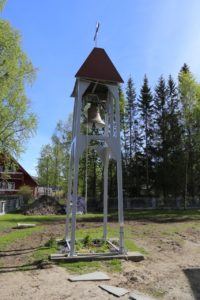
Det er ikke bortkastet tid å bruke jubileumsåret til å fornye de historiske kunnskapene om Kirken i Norge. Et viktig formål med jubileumsfeiringen er å gi mulighet for ny inspirasjon i vårt religiøse liv her langt mot nord. Selv om Kirken verdslig sett også her nord har fulgt godt med i den øvrige samfunnsutviklingen, er det åpenbart at Kristus fortsatt trenger disipler med brennende tro og glødende engasjement til uopphørlig å formidle evangeliet til dagens og fremtidens mennesker.
Kilde: Den katolske kirke
![]() North Pole Mission (Praefectura Apostolica Poli Arctici) was a Catholic apostolic prefecture which was created in 1855 to do mission work. This should take place primarily in the areas north of the Arctic Circle, but also some other areas were taken. The scope covered thus:
North Pole Mission (Praefectura Apostolica Poli Arctici) was a Catholic apostolic prefecture which was created in 1855 to do mission work. This should take place primarily in the areas north of the Arctic Circle, but also some other areas were taken. The scope covered thus:
• Norway and Sweden north of the Arctic Circle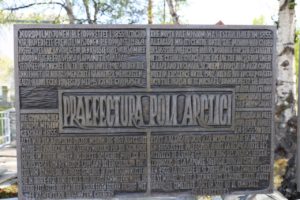
• Kola Peninsula
• Island
• Greenland
• Faroe Islands
• Arctic North America from Baffin Bay to Melville
• Shetland
• Orkney
• Caithness in Scotland
The creation was made December 8,1855 by the Sacred Congregation for the Faith spread in a decree signed by the prefect Giacomo Filippo kard. Fransoni. North Pole mission had 1856-1865 headquartered in Alta Farm Alta.
The first head of the mission was Paul Marie Etienne de Djunkovskij
In 1869, the mission was dissolved by Pope Pius IX. They realized that Roman Catholicism in Norway had to be organized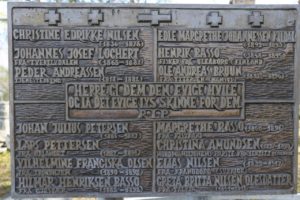 differently. Some churches that were created through the North Pole mission still exists, as St. Michael in Hammerfest.
differently. Some churches that were created through the North Pole mission still exists, as St. Michael in Hammerfest.
Source: Wikipedia
/esh
North Pole mission is 150 years
See also papal documents in connection with the establishment of the North Pole Mission. (Helmut Krane, Tromso)
In 2005, 150 years ago Rome created «Praefectura Apostolica Poli Arctici» with the purpose to drive mission preferably in areas north of the Arctic Circle. «The mission in the Arctic», commonly referred to as «North Pole mission», comprised of the largest Arctic parts of Norway and Sweden, the Kola Peninsula, Iceland, Greenland, Faroe Islands, Arctic America from Baffin Bay to the island Melville, Shetland Islands, Orkney and the county of Caithness in Scotland.
Historical material about the mission’s had many sources, especially in «Norvegia Catholic» (Kjelstrup 1942 «Roman Catholicism in No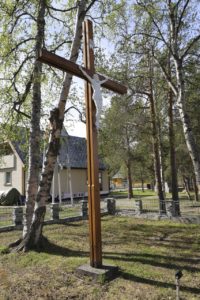 rway» (1943), «North Pole mission» (p. Alois Brodersen mag.gr.avh.) And Carmelite Sister Nadas booklet from 1993 ( «the Catholic Church in northern Norway from 1537 to 1932»). the latter gives a concise version history of the prefect Paul Maria Stefan de Djunkowsky spearheaded a group of 6 who came to Alta in 1856. Alta was chosen as the base to missionary work, and here they immediately created a chapel, and a boy’s school started in1857. The people sent out on mission to Iceland, Scotland, Shetland Islands and the Faroe Islands and they collected money on the Continent. In 1859, the Church was established in Tromsø. There were many activities. Today, one can simply not do anything but bow his head for the burning commitment of these few people, who went into the literally unimaginable task.
rway» (1943), «North Pole mission» (p. Alois Brodersen mag.gr.avh.) And Carmelite Sister Nadas booklet from 1993 ( «the Catholic Church in northern Norway from 1537 to 1932»). the latter gives a concise version history of the prefect Paul Maria Stefan de Djunkowsky spearheaded a group of 6 who came to Alta in 1856. Alta was chosen as the base to missionary work, and here they immediately created a chapel, and a boy’s school started in1857. The people sent out on mission to Iceland, Scotland, Shetland Islands and the Faroe Islands and they collected money on the Continent. In 1859, the Church was established in Tromsø. There were many activities. Today, one can simply not do anything but bow his head for the burning commitment of these few people, who went into the literally unimaginable task.
In 1869 they dissolved the Rome North Pole mission. The Church had to be organized in a completely different way in the north. But it rooted well in northern Norway that the Church could continue to grow by congregations. They establish it in several places, and St Elisabeth sisters begin their great work in northern Norway after coming to Hammerfest in 1880. (They Celebrated 125th anniversary in 2015.)
Pastoral Council of Tromsø Stift planned an anniversary celebration of the North Pole Mission’s which was established in 1856. It has actually been a national and Nordic importance. The Nordic Episcopal Conference will mark this by holding its autumn meeting in 2006 in Alta on September 9.
It’s not a waste of time to use the anniversary year to renew the historical knowledge about the Church in Norway. An important purpose of the anniversary celebration is to provide opportunity for new inspiration in our religious lives here in the far north. Although church worldly seen also here in the north have followed well with the other social development. It is obvious that Christ still need disciples with burning faith, ardent commitment and incessant communication about the gospel to the current and future people.
Source: The Catholic Church
/esh

